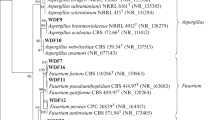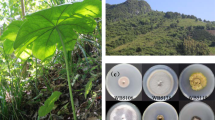Abstract
An endophytic fungus (strain T1) isolated from Taxus baccata was studied for the production of metabolites with anticancer and antioxidant activities. This fungus was identified as Diaporthe sp. based on rDNA-internal transcribed spacer (ITS) sequence analysis. The crude extract showed cytotoxic activity against MCF-7 and HeLa cancer cell lines, with IC50 (concentration inhibiting 50% of growth rate) values of 1058 ± 44 and 1257 ± 80 μg ml−1, respectively. The scavenging activity of fungal extract increased significantly with increasing concentration [IC50 (concentration required to scavenge 50% of free radicals) 482 ± 9 μg ml−1]. Ultra-high-performance liquid chromatography-quadrupole-time of flight analysis revealed the presence of three trichalasins (trichalasin E, F and H) in the crude extract of T1 which are known to have antitumour and antioxidant activities. These results suggest that Diaporthe sp. has the potential to be used for therapeutic purposes because of its antiproliferative and antioxidant potential and also for the production of cytochalasins.




Similar content being viewed by others
References
Agusta A, Ohashi K, Shibuya H (2006) Bisanthraquinone metabolites produced by the endophytic fungus Diaporthe sp. Chem Pharm Bull 54:579–582
Ascêncio PGM, Ascêncio SD, Aguiar AA, Fiorini A, Pimenta RS (2014) Chemical assessment and antimicrobial and antioxidant activities of endophytic fungi extracts isolated from Costus spiralis (Jacq.) Roscoe (Costaceae). Evidence-based complementary and alternative medicine. Article ID 190543. doi:10.1155/2014/190543
Bacon CW, White JF (2000) Microbial endophytes. Marcel Deker Inc., New York: CRC Press
Cabezas L, Calderon C, Medina LM, Bahamon I, Cardenas M, Bernal AJ, Gonzalez A, Restrepo S (2012) Characterization of cellulases of fungal endophytes isolated from Espeletia spp. J Microbiol 50:1009–1013
Carvalho CR, Gonçalves VN, Pereira CB, Johann S, Galliza IV, Alves TMA, Rabello A, Sobral MEG, Zani C, Rosa CA, Rosa LH (2012) The diversity, antimicrobial and anticancer activity of endophytic fungi associated with the medicinal plant Stryphnodendron adstringens (Mart.) Coville (Fabaceae) from the Brazilian savannah. Symbiosis 57:95–107
Casella TM, Eparvier V, Mandavid H, Bendelac A, Odonne G, Dayan L, Duplais C, Espindola LS, Stien D (2013) Antimicrobial and cytotoxic secondary metabolites from tropical leaf endophytes: Isolation of antibacterial agent pyrrocidine C from Lewia infectoria SNB-GTC2402. Phytochemistry 96:370–377
Chen L, Liu YT, Song B, Zhang HW, Ging G, Liu XZ, Gu YC, Zou ZM (2014) Stereochemical determination of new cytochalasins from the plant endophytic fungus Trichoderma gamsii. Fitoterapia 96:115–122
Corrêa RC, Rhoden SA, Mota TR, Azevedo JL, Pamphile JA, de Souza CG, Polizeli Mde L, Bracht A, Peralta RM (2014) Endophytic fungi: expanding the arsenal of industrial enzyme producers. J Ind Microbiol Biotechnol 41:1467–1478
Denizot F, Lang R (1986) Rapid colorimetric assay for cell growth and survival: Modifications to the tetrazolium dye procedure giving improved sensitivity and reliability. J Immunol Method 89:271–277
Deshmukh SK, Verekar SA, Bhave SV (2015) Endophytic fungi: a reservoir of antibacterials. Front Microbiol 8:715. doi:10.3389/fmicb.2014.00715
Dos Santos TT, de Souza LT, de Queiroz CB, de Araújo EF, Pereira OL, de Queiroz MV (2016) High genetic variability in endophytic fungi from the genus Diaporthe isolated from common bean (Phaseolus vulgaris L.) in Brazil. J Appl Microbiol 120:388–401
Eaton CJ, Cox MP, Scott B (2011) What triggers grass endophytes to switch from mutualism to pathogenism? Plant Sci 180:190–195
Eriksson OE, Vue JZ (1998) Bambusicolous pyrenomycetes, an annotated check-list. Myconet 1:25–78
Garyali S, Kumar A, Reddy MS (2013) Taxol production by an endophytic fungus, Fusarium redolens, isolated from Himalayan yew. J Microbiol Biotechnol 23:1372–1380
Guo LD, Hyde KD, Liew ECY (2000) Identification of endophytic fungi from Livistona chinensis based on morphology and rDNA sequences. New Phytol 147:617–630
Hall TA (1999) BioEdit: a user-friendly biological sequence alignment editor and analysis program for Windows 95/98/NT. Nucleic Acids Symp Ser 41:95–98
Katoh K, Standley DM (2013) MAFFT multiple sequence alignment software version 7: improvements in performance and usability. Mol Biol Evol 30:772–780
Kharwar RN, Mishra A, Gond SK, Stierle A, Stierle D (2011) Anticancer compounds derived from fungal endophytes: their importance and future challenges. Nat Prod Rep 28:1208–228
Koleva II, van Beek TA, Linssen JP, de Groot A, Evstatieva LN (2002) Screening of plant extracts for antioxidant activity: a comparative study on three testing methods. Phytochem Anal 13:8–17
Lin X, Huang Y, Fang M, Wang J, Zheng Z, Su W (2005) Cytotoxic and antimicrobial metabolites from marine lignicolous fungi, Diaporthe sp. FEMS Microbiol Lett 251:53–58
Liu K, Ding X, Deng B, Chen W (2009) Isolation and characterization of endophytic taxol-producting fungi Taxus chinensis. J Ind Microbiol 36:1171–1177
Naik BS, Shashikala J, Krishnamurthy YL (2008) Diversity of fungal endophytes in shrubby medicinal plants of Malnad region, Western Ghats, Southern India. Fungal Ecol 1:89–93
Nath A, Raghunatha P, Joshi SR (2012) Diversity and biological activities of endophytic fungi of Emblica officinalis, an ethnomedicinal plant of India. Mycobiology 40:8–13
Nisa H, Kamili AN, Nawchoo IA, Shafi S, Shameem N, Bandh SA (2015) Fungaal endophytesas prolific source of phytochemicals and other bioactive natural products: A review. Microb Pathog 82:50–59
Pornpakakul S, Roengsumran S, Deechangvipart S, Petsom A, Muangsin N, Ngamrojnavanich N, Sriubolmas N, Chaichit N, Ohta T (2007) Diaporthichalasin, a novel CYP3A4 inhibitor from an endophytic Diaporthe sp. Tetrahedron Lett 48:651–655
Priti V, Ramesha BT, Singh S, Ravikanth G, Ganeshaiah KN, Suryanarayanan TS, Shaanker RU (2009) How promising are endophytic fungi as alternative sources of plant secondary metabolites? Curr Sci 97:477–478
Rukachaisirikul V, Sommart U, Phongpaichit S, Sakayaroj J (2008) Metabolites from the endophytic fungus Phomopsis sp. PSU-D15. Phytochemistry 69:783–787
Scherlach K, Boettger D, Remme N, Hertweck C (2010) The chemistry and biology of cytochalasans. Nat Prod Rep 27:869–886
Schulz B, Boyle C (2005) The endophytic continuum. Mycol Res 109:661–686
Silva GH, Teles HL, Trevisan HC, Young MCM, Pfenning LH, Eberlin MN, Haddad R, Costa-Neto CM, Bolzani VS, Araújo AR (2005) New bioactive metabolites produced by Phomopsis cassiae, an endophytic fungus in Cassia spectabilis. J Braz Chem Soc 16:1463–1466
Soca-Chafre G, Rivera-Orduña FN, Hidalgo-Lara ME, Hernandez-Rodriguez C, Marsch R, Flores-Cotera LB (2011) Molecular phylogeny and paclitaxel screening of fungal endophytes from Taxus globosa. Fungal Biol 111:143–156
Strobel G, Daisy B (2003) Bioprospecting for microbial endophytes and their natural products. Microbiol Mol Biol Res 67:491–502
Suryanarayanan TS, Thirunavukkarasu N, Govindarajulu MB, Sasse F, Jensen R, Murali TS (2009) Fungal endophytes and bioprospecting. Fungal Biol Rev 23:9–19
Tejesvi MV, Nalini MS, Mahesh B, Parkash SH, Kinni RK, Shetty HS, Subbiah V (2007) New hopes from endophytic fungal secondary metabolite. Bol Soc Quim Mex 1:19–26
Van Niekerk JM, Groenewald JZ, Farr DF, Fourie PH, Halleer F, Crous PW (2005) Reassessment of Phomopsis species on grapevines. Australas Plant Pathol 34:1–13
Vieira ML, Hughes AF, Gil VB, Vaz AB, Alves TM, Zani CL, Rosa CA, Rosa LH (2012) Diversity and antimicrobial activities of the fungal endophyte community associated with the traditional Brazilian medicinal plant Solanum cernuum Vell. (Solanaceae). Can J Microbiol 58:1–13
Wagenaar MM, Corwin J, Strobel G, Clardy J (2000) Three new cytochalasins produced by an endophytic fungus in the Genus Rhinocladiella. J Nat Prod 63:1692–1695
White TJ, Bruns T, Lee S, Taylor J (1990) Amplification and direct sequencing of fungal ribosomal RNA genes for phylogenetics. In: Innis MA, Gelfand DH, Sninsky JJ, White TJ (eds) PCR protocols: a guide to methods and application. Academic, San Diego, pp 315–322
Yan BC, Wang WG, Hu DB, Sun X, Kong LM, Li XN, Du X, Luo SH, Liu Y, Li Y, Sun HD, Pu JX (2016) Phomopchalasins A and B, two cytochalasans with polycyclic-fused skeletons from the endophytic fungus Phomopsis sp. shj2. Org Lett 18:1108–1111
Zhang P, Zhou PP, Jiang C, Yu H, Yu LJ (2008) Screening of taxol-producing fungi based on PCR amplification from Taxus. Biotechnol Lett 30:2119–2123
Author information
Authors and Affiliations
Corresponding author
Electronic supplementary material
Below is the link to the electronic supplementary material.
ESM 1
(DOCX 13 kb)
Rights and permissions
About this article
Cite this article
Vasundhara, M., Baranwal, M., Sivaramaiah, N. et al. Isolation and characterization of trichalasin-producing endophytic fungus from Taxus baccata . Ann Microbiol 67, 255–261 (2017). https://doi.org/10.1007/s13213-017-1256-4
Received:
Accepted:
Published:
Issue Date:
DOI: https://doi.org/10.1007/s13213-017-1256-4




